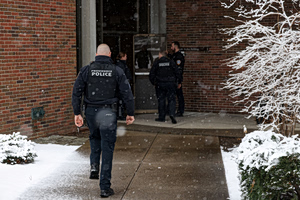Some Minnesotans figured they were getting a moderate Democrat—an increasingly rare species—when they elected Tim Walz governor in 2018.
He had grown up in small-town Nebraska, enlisted in the Army National Guard at 17, was elected to Congress from one of the state’s more conservative districts and once earned the National Rifle Association’s endorsement.
But Walz, now on Kamala Harris ’s shortlist for the vice-presidential slot , has governed more to the left than expected. He supported universal free school meals for students, voting rights for the formerly incarcerated, driver’s licenses for migrants who crossed the border illegally, and recreational marijuana, and he signed a law that made abortion a “fundamental right.”
To win in November, Harris likely needs to do the reverse of what Walz did. She already is distancing herself from some of the more progressive parts of her record, some dating from her 2020 Democratic presidential primary campaign, in a gradual move to the middle, even as former President Donald Trump works to brand her a San Francisco “ultraliberal.”
Walz, a two-term governor and current chairman of the Democratic Governors Association, might have some lessons to share with Harris on how to make the pivot. He might also be able to help her trim Republican margins in rural America, where Trump is especially strong .
Known for his folksy dress and manner, Walz likely would help Harris the most in battleground Wisconsin because he is already well-known in western portions of that state that share media markets with Minnesota. He might also play well in battleground Michigan—one-third of the “blue wall,” along with Wisconsin and Pennsylvania, seen as crucial to Harris’s hopes in November.
Minnesota hasn’t backed a Republican for president since Richard Nixon in 1972, but Trump came within 1.5 percentage points in 2016. He and his running mate, Ohio Sen. JD Vance , appeared in the state last weekend.
“The surest path for Kamala Harris to win the presidency still goes through the Midwest,” said Ken Martin, chair of the Minnesota Democratic-Farmer-Labor Party, which is affiliated with national Democrats. “He speaks to those Midwest sensibilities. There is nobody who will be able to out-small-town Tim Walz.”
Martin described Walz as a “veteran, hunter and gun owner,” highlighting experiences that often help candidates in rural areas. The governor is as comfortable in front of voters in his Democratic-leaning state wearing a flannel shirt and baseball cap as he is in a suit and tie.
Harris is expected to make a decision by early next week and then campaign with her new running mate in several states, starting Tuesday in Philadelphia. The pairing is expected to be nominated virtually early this month ahead of the Aug. 19 start of the Democratic National Convention in Chicago.
Walz, 60 years old, is less well-known nationally than some of the others Harris is considering , including Sen. Mark Kelly of Arizona and Gov. Josh Shapiro of Pennsylvania.
But he has gained some Democratic fans outside Minnesota in recent weeks for his ability to do television interviews that hit Trump and Vance without being overly nasty.
“These guys are just weird,” Walz said in a recent MSNBC appearance, a line that has since gone viral among Democrats, including Harris.
After graduating in 1989 with a social-science degree from Chadron State College in Nebraska, Walz spent a year teaching in China before returning to full-time status at the National Guard and then a teaching career. He eventually landed about 80 miles southwest of Minneapolis in Mankato, Minn., where he taught social studies, coached high-school football and raised two children with his wife, Gwen Walz.
He also continued in the National Guard, where he specialized in field artillery and did a tour overseas, although he never saw combat. After 24 years in the National Guard, he retired as a command sergeant major before he first ran for Congress in 2006.
In his early 40s, Walz entered politics and managed to unseat a six-term Republican congressman in a mostly rural southern Minnesota district. His humor, polished by years of trying to keep high-schoolers’ attention, has been a strength throughout his political career.
After 12 years in Congress, Walz ran for governor as someone willing to compromise with Republicans. He won by 11.4 percentage points in 2018, almost four points higher than his 2022 re-election victory.
Minnesota became something of a laboratory in 2023 for many of the Democratic Party’s policy goals, once Walz had a legislature fully controlled by Democrats. Besides establishing the goal of a carbon-free electrical grid by 2040, the state also passed paid family and medical leave, sick leave, transgender-rights protections, a tax credit aimed at low-income parents, and a $1 billion investment in affordable housing.
“If you need a reminder that elections have consequences, check out what’s happening in Minnesota,” former President Barack Obama wrote on social media last year .
Republican Paul Gazelka , an insurance agent and former state Senate majority leader, said Walz was more of a moderate when he was first elected. That changed, he said, after Democrats held the governor’s office and both legislative chambers.
“He morphed into an extreme liberal who matches Kamala Harris,” said Gazelka, who unsuccessfully ran for the GOP nomination for governor in 2022. “He may be a good fit for her, but there was a change in him that surprised many.”
More concerning, Gazelka said, was how Walz in his view was slow to call out the Minnesota National Guard to address rioting that started after the Minneapolis police murder of George Floyd in 2020.
The rioting resulted in significant damage, including when a police precinct was set on fire. Walz deployed hundreds of National Guard troops three days after Floyd’s murder as looting and arson spread.
“My biggest concern for him as a VP candidate is that he is bad in a crisis. Tim Walz froze,” Gazelka said. “I think he was trying to thread the needle between part of his base that was protesting and rioting and protecting the state.”
City and state officials have blamed each other for the response. After-action assessments found a breakdown in communication between government officials, the Star Tribune newspaper in Minnesota has reported.
A Walz spokesman didn’t respond to requests for an interview with the governor. Like others thought to be on the Harris list, he has demurred publicly about his interest in being a vice presidential candidate.
Blois Olson, the publisher of a newsletter about Minnesota politics who has known Walz since 2006, said the governor can be thin-skinned when criticized and has proved to be more liberal than many expected.
Olson said Walz can be “very crafty” in the way that he navigates politics and rivals, while still wearing a smile on his face. “It’s a lot of aw-shucks,” he said.
Write to John McCormick at mccormick.john@wsj.com


